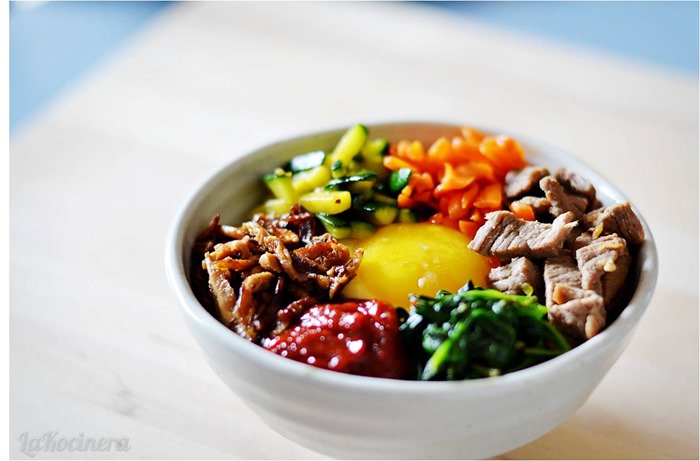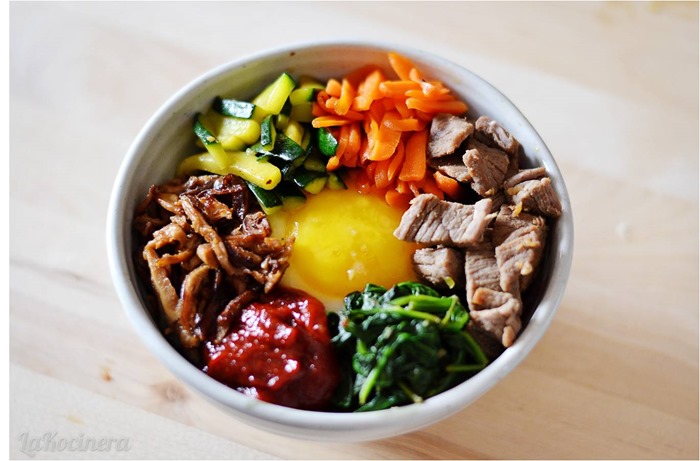This recipe definitely falls under my “favorites” category—along with soft baked cookies, funky cheeses, and anything coffee-flavored. Perhaps it’s because Bibimbap perfectly caters to my love of sampling a ton of delicious foods at once. Thanks to oodles of separately prepared, almost mini dishes, Bibimbap is extra full of flavor, plus it can be tailored however you like it.
Also, as you may know if you’ve seen any of my Monthly Language Reports on YouTube, I’m currently learning Korean and definitely one of my favorite things about Korea and Korean culture is the food. I think I’ve basically loved every Korean dish that I’ve tried, so it’s always fun to share another favorite here on La Kocinera.
Before I further delve into my love of Bibimbap, however, I think it might be helpful to briefly explain what Bibimbap is for any of you who might be new to this yummy creation. Basically, Bibimbap is a Korean dish composed of rice, some type of meat, plus a whole bunch of different veggies and sides, cooked to delicious perfection and beautifully arranged in its characteristic ring of colorful ingredients. The same colorful ring of beauty that you subsequently thoroughly mix together to produce a bowl full of awesome, savory, spicy flavor.
Sounds pretty good, huh?
While there are plenty of different versions of Bibimbap and lots of ingredients that various cooks would swear by, this combination is my current favorite. The meat in question is marinated steak, the veggies a delicious blend of woodsy shiitake mushrooms, toothsome carrots, yummy zucchini, and sautéed baby spinach. Finally there’s a sunny-side up egg and a healthy scoop of gochujang (Korean red pepper paste) to mix together as well.
And, as a bonus, we’ve also got a brand new YouTube video—in both English and Spanish as always—to guide you on your amazing Bibimbap journey!
Hope you enjoy!
Bibimbap (비빔밥)
Rather than an “original” recipe, this is my beginner approximation of how I make bibimbap, pulling from different recipes I’ve tried over time
*Ingredients listed separately for each component*
Beef
3 medium steaks, thinly sliced (or buy them pre-sliced if you can)
2 tablespoons low sodium soy sauce
1 medium pinch dark brown sugar
1 small splash sesame oil
2 cloves garlic, minced
Spinach
6 ounces (170 grams) baby spinach
1 clove garlic, minced
1 tablespoon low sodium soy sauce
Carrots
3 ounces (85 grams) baby carrots
½ teaspoon salt
½ tablespoon honey
Splash of sesame oil
Shiitake Mushrooms
5 ounces (140 grams) shiitake mushrooms
Splash of sesame oil
1 tablespoon low sodium soy sauce
Pinch of dark brown sugar
Zucchini
1 large zucchini
½ teaspoon salt
Miscellaneous
4-5 eggs (one per serving)
Sushi rice or any kind of short-grain rice
1 tablespoon vegetable oil, plus more as needed
Gochujang (고추장) (Korean red pepper paste), to taste for each serving (optional)
Prepare rice according to package instructions and allow it to cook while preparing the other ingredients.
Place the sliced steak in a glass or metal bowl. Add the soy sauce, dark brown sugar, sesame oil, and minced garlic, mixing well to combine. Refrigerate while preparing the vegetables.
Thinly slice the mushrooms and carrots into long strips.
*Tip* If your mushrooms smell fishy, don’t use them.
Cut the zucchini widthwise into thirds then cut each section lengthwise into thin strips. Finally, cut each of those strips into matchsticks (see the video for a demonstration). Set all vegetables aside.
Heat 1 tablespoon vegetable oil in a large pan over medium-high heat. Add the beef, plus any leftover marinade, to the pan and cook, stirring frequently, until the meat is browned and cooked through. Set aside on paper towels to drain and cover with aluminum foil to keep warm.
In the same pan, add more vegetable oil if needed, then add the mushrooms to the leftover meat juices. Also add the sesame oil, soy sauce, and dark brown sugar. Cook, stirring frequently, until the mushrooms are browned and softened. Again, set them aside on paper towels to drain and cover with aluminum foil.
Next cook the carrots, along with the salt, honey, and sesame oil over medium-high heat (you can lower the heat if your pan is getting too hot) until softened and set aside on paper towels and cover.
Cook the sliced zucchini with the salt until browned and softened, then set aside on paper towels and cover.
Add more oil to the pan as necessary, then sauté the baby spinach with the salt and minced garlic until the spinach is wilted, but still green. Again, set aside on paper towels and cover.
Finally, fry 1 egg sunny-side up for each serving of bibimbap with a pinch of salt (this recipe should make 4-5 servings, depending on serving size). Briefly set aside.
To assemble the bibimbap, first place a layer of cooked rice at the bottom of each bowl, then top each one with a fried egg. Arrange the vegetables and gochujang, to taste, in sections surrounding the egg.
Serve immediately. To eat bibimbap, simply take a spoon and mix together all the ingredients until fully combined and enjoy!
Makes 4—5 servings.
Bibimbap (비빔밥)
En vez de una receta “original,” esta es una aproximación principiante de cómo yo preparo bibimbap, que es una combinación de recetas que he probado con el paso del tiempo
*Los ingredientes están enumerados separadamente por cada componente*
Bistec
3 bistecs medianos, cortados en rebanadas finas (o cómprelos ya cortados por el supermercado si pueda)
2 cucharadas salsa de soja baja en sodio
1 pizca mediana de azúcar moreno oscuro (dark brown sugar)
Un toque de aceite de sésamo
2 dientes de ajo, picados finamente
Espinacas
6 onzas (170 gramos) espinacas <<baby>>
1 diente de ajo, picado finamente
1 cucharada salsa de soja baja en sodio
Zanahorias
3 onzas (85 gramos) zanahorias <<baby>>
½ cucharadita sal
½ cucharada miel
Un toque de aceite de sésamo
Champiñones Shiitake
5 onzas (140 gramos) champiñones shiitake
Un toque de aceite de sésamo
1 cucharada salsa de soja baja en sodio
Pizca de azúcar moreno oscuro (dark brown sugar)
Calabacín
1 calabacín grande
½ cucharadita sal
Miscelánea
4 a 5 huevos (uno para cada porción)
Arroz sushi o cualquier tipo de arroz corto (short-grain rice)
1 cucharada aceite vegetal, más si lo necesite
Gochujang (고추장) (pasta de pimienta roja coreana), al gusto para cada porción (opcional)
Prepare el arroz según las instrucciones de la caja y déjelo cocinar mientras prepara los otros ingredientes.
Ponga el bistec cortado en un bol de vidrio o metal. Añada la salsa de soja, azúcar moreno oscuro, aceite de sésamo, y ajo picado, mezclándolos bien para combinar. Refrigérelo mientras prepara las verduras.
Corte los champiñones y las zanahorias en rebanadas finas.
*Consejo* Si los champiñones huelan a pescado, no los use.
Corte el calabacín a lo ancho en tres porciones. Después corte cada porción a lo large en rebanadas finas. Finalmente, corte cada de esas tiras en palitos (consulte el video para un ejemplo). Ponga todas las verduras aparte.
Caliente 1 cucharada de aceite vegetal en un sartén grande sobre fuego medio-alto. Añada el bistec con la marinada al sartén y cocine, revolviéndolo frecuentemente, hasta que el bistec esté dorado y completamente cocido. Póngalo aparte por toallas de papel para desaguarse y cúbralo con papel de aluminio para mantenerlo caliente.
En el mismo sartén, añada más aceite vegetal si es necesario, y después añada los champiñones para cocinar en el jugo sobrante del bistec. También añada el aceite de sésamo, la salsa de soja, y el azúcar moreno oscuro. Cocine, revolviéndolo frecuentemente, hasta que los champiñones estén dorados y blandos. Otra vez póngalos aparte por toallas de papel para desaguarse y cúbralos con papel de aluminio para mantenerlos caliente.
Cocine las zanahorias, con la sal, la miel, y el aceite de sésamo a fuego medio-alto (se puede bajar el fuego si el sartén se ponga demasiado caliente) hasta que estén blandas y póngalas aparte por toallas de papel y cúbralas.
Cocine el calabacín con sal hasta que esté dorado y blando, después pongándolo aparte por toallas de papel y cubierto.
Añada más aceite al sartén si es necesario, y después cocine las espinacas baby con la sal y el ajo picado hasta que las espinacas estén marchitadas, pero todavía verdes. Otra vez, póngalas aparte por toallas de papel y cúbralas.
Finalmente, fríe un huevo estrellado (o <<sunny-side up>>) para cada porción de bibimbap con una pizca de sal (esta receta debe hacer 4 a 5 porciones, dependiendo del tamaño de cada porción). Brevemente póngalo aparte.
Para hacer el bibimbap, primero ponga una capa de arroz cocida al fondo de cada bol, y después ponga un huevo frito por encima. Ponga las verduras y el gochujang, al gusto, rodeando el huevo en secciones.
Sirva inmediatamente. Para comer bibimbap, sólo hay que usar una cuchara para mezclar todos los ingredientes hasta que estén completamente combinados ¡y disfrutar!
Hace 4 a 5 porciones.



I love your videos. They're so soothing to watch, and your Bibimbap is beautiful!
The boyfriend's mom makes this so well but I'd love to try this myself!
Koci, this is such a sunny colourful dish, and despite the long list of ingredients, relatively easy to prepare. Edible photos as ever. (I'm learning Spanish so your Spanish version is enormously helpful and much more fun than grammar books)